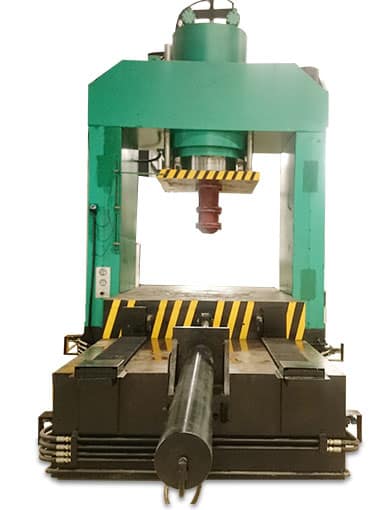How to Build a Hydraulic Press Brake
time:2023-05-13 views:(点击 866 次)
Hydraulic press brakes can bend, shear and punch sheet metal as well as straighten and pierce metal plates and tubes, but errors are likely to happen due to user error.
To prevent errors, your operators should implement a weekly recommended maintenance routine. They should clean back gauges, guides and other parts of the machine as well as inspect for looseness.
The frame
The frame is the foundation of a press brake that holds all its components together. This includes a bolster plate and columns to support workpieces as they are bent by the ram and die, while die cushions on its bolster plate offer counter draw forces during bending processes.
The hydraulic system is also mounted to the frame and includes a motor, oil pump and oil filling valve. The pump transforms mechanical energy into hydraulic pressure that powers a cylinder that in turn drives ram.
Press brakes are versatile machines capable of bending a variety of different materials. Their punches and dies allow them to produce multiple angled bends at the same time, significantly reducing production costs while accommodating large parts with greater precision than other forms. When shopping for one, take into consideration which projects you will be working on as well as your desired precision level - this will help determine the ideal machine.
The ram
Press brake rams are moving mechanisms designed to bend sheet metal sheets. Controlled by a mechanical crank mechanism and flywheel, they can exert both upwards and downward motions when in motion, as well as feature crowning mechanisms which evenly distribute force distribution during use.
The ram is propelled by a hydraulic system consisting of two synchronized hydraulic cylinders connected to C-frames that move the upper beam, fed from a high-precision flow control valve, which ensures it can exert ample power cost-effectively.
Most modern press brakes use either servo motors or CNC (Computer Numeric Control) systems to move their ram. Fabricators can program bending operations ahead of time and run them by simply running this new machine - not to mention that its ergonomic advantages far surpass that of its mechanical predecessors; such as high speed ram movement, reduced energy usage and faster response times.
The die
As its name implies, the die of a hydraulic press brake is what actually bends metal sheet or plate into its desired form. They come in various sizes and shapes; from standard single V bending machines to four, five, six sided and U/Z bend types - each designed for specific bending applications.
Press brake operators rely on top and bottom tooling (punches and dies respectively) to give their machine power and precision. Get this right and you will achieve superior quality bends while making maintenance and operation of your press brake much simpler.
Wrong approach could result in low bending accuracy, poor productivity and safety risks. To combat these problems, regular inspection of the entire system is the solution - this will identify any factors needing attention such as worn out punches or need for new bottom dies that need repairing or replacement.
The hydraulic system
Press brakes are large mechanical machines that use hydraulic cylinders to bend metal, controlled via a hydraulic pump and series of valves. Each cylinder features an automatic crowning system which helps protect workpieces. Furthermore, their frame may either be C-shaped or square in shape made from welded steel plates with monitoring tools to detect springback and minimize it as much as possible.
Press brakes require considerable force to bend metal sheets, so selecting an appropriately-sized machine is essential for success. You can find your ideal tonnage by consulting a press brake bending chart or consulting with a professional. Flange length and thickness must also be considered; for instance, these factors determine V-die width requirements which in turn determines amount of pressure necessary - wider flanges require greater tonnages than narrow ones.
Link to this article: https://www.ihydraulicpress.com/mk/2899.html
Hot Articles
-
Hydraulic Press for Ship Hull Repair
Hydraulic presses are versatile pieces of equipment used for various tasks. Examples include thinneing glass, crushing cars and making powders. Cold……
-
Hydraulic Press Machine – Find a Hydraulic Press Machine Near Me
Hydraulic presses are highly sought-after for their adaptability and capacity to meet a variety of forming needs, making them an indispensable piece……
-
How to Make a Hydraulic Press for Jewelry
Discover new technologies involving a hydraulic press that save time and tooling costs when producing jewelry. These methods range from sheet meta……
-
一般电路图分为电气图和电子电路图,会教你怎么看电路图
电路设计看上去密麻麻,比较分析复杂,事实上它遵循一个简易的规律性。拼图液压机与传统的冲压工艺相比,液压成形工艺在减轻重量、减少零件数量和模具数量、提……
-
Hydraulic Press for Circuit Board Assembly
Hydraulic presses are powerful machines that can compress or cut, punch, drill, straighten and mold large pieces of metal or strong material in any ……
-
Hydraulic Press for Olive Oil Extraction
To begin the production of olive oil, the first step involves grinding olives with a stone mill. This paste then gets spread onto woven mats –……
-
Can a Hydraulic Press Crush a Person’s Head?
Hydraulic presses are powerful machines capable of exerting tremendous forces. They’re widely used across a range of applications – me……
-
Why Were Hydraulic Presses Invented?
Hydraulic presses use liquid pressure to produce enormous force, using Pascal’s principle which states that an enclosed fluid maintains const……
Latest News
-
Safety Tips When Using a Hydraulic Press
When operating a hydraulic press, it is essential to adhere to safety protocols. Neglecting to do so could result in serious injuries which are both……
-
Hydraulic Press for Asphalt Repair
Asphalt repair requires the use of hydraulic presses, which are cost-effective methods to produce high quality repairs that require less upkeep. A h……
-
What is Three a Billion Ton Hydraulic Press?
Hydraulic presses are large-scale metal fabrication tools that rely on Pascal’s principle: pressure in closed systems is constant. This enab……
-
Hydraulic Press For Moulding – Creating High-Precision Components With the Right Materials and Processes
In today’s manufacturing world, there is an ever-increasing need for precision parts with superior physical characteristics. Producing these k……
-
How Many Pounds of Pressure in a Hydraulic Press?
Hydraulic presses play an indispensable role in industrial settings. They assist with fabrication, assembly and maintenance tasks related to mater……
-
How to Bleed a Hydraulic Press
A hydraulic press is a machine that utilizes liquids to compress items into large chunks. It consists of two interconnected cylinders – the la……
-
Hydraulic Press For Laminating
Hydraulic presses are machines that exert force by using liquids, usually water. As such, hydraulic presses have greater efficiency than their mecha……
-
How to Use a Disc Cutter on a Hydraulic Press
People frequently utilize hydraulic presses for making jewelry and crafts, while auto manufacturers also employ them for shaping and assembling ca……















































